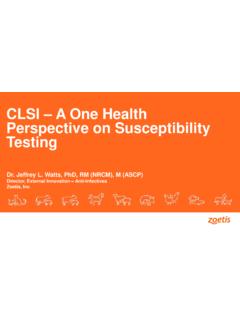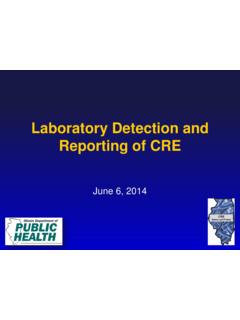Transcription of European Committee on Antimicrobial Susceptibility …
1 GeneralPageNotes1 Changes2 Routine quality controlPageEscherichia coli ATCC 259223 Escherichia coli ATCC 352185 Pseudomonas aeruginosa ATCC 278536 Staphylococcus aureus ATCC 292137 Enterococcus faecalis ATCC 292128 Streptococcus pneumoniae ATCC 496199 Haemophilus influenzae NCTC 846810 Haemophilus influenzae ATCC 4976611 Campylobacter jejuni ATCC 3356012 Extended quality control for detection of resistance mechanismswith disk diffusionPageKlebsiella pneumoniae ATCC 70060313 Staphylococcus aureus NCTC 12493 13 Enterococcus faecalis ATCC 5129913 Haemophilus influenzae ATCC 4924714 European Committee on Antimicrobial Susceptibility Testing Routine and extended internal quality control as recommended by EUCASTV ersion , valid from 2015-01-09 This document should be cited as "The European Committee on Antimicrobial Susceptibility Testing.
2 Routine and extended internal quality control as recommended by EUCAST. Version , 2015. "EUCAST QC Tables v. , valid from 2015-01-09 Notes1. In EUCAST quality control (QC) tables, both ranges and targets are listed. Repeat testing of EUCAST quality control strains should yield individual MIC and zone diameter values randomly distributed within the recommended ranges. If the number of tests is 10, the mode MIC should be the target value and the mean zone diameter should be close to the target value. 2. For access to ISO standard documents, see EUCAST quality control strains for routine QC are used to monitor test performance.
3 Control tests should be set up and checked daily, at least for antibiotic agents which are part of routine panels. For analysis of the QC test results, see EUCAST Disk Diffusion Manual, section E. coli ATCC 35218 (TEM-1 -lactamase-producing strain) is recommended to check the inhibitor component of penicillin inhibitor-combination disks for Antimicrobial Susceptibility testing of Enterobacteriaceae and should be part of the routine QC. E. coli ATCC 25922 is used to check the active EUCAST quality control strains for extended QC are complementary to the EUCAST routine quality control strains. These strains are recommended for detection of specific resistance mechanisms (ESBL, MRSA, VRE, HLGR and PBP mutations) and are used to check that routine Susceptibility testing will result in the correct S, I and R categorisation.
4 Extended QC should be performed with any change in the Susceptibility testing system (with each new batch of disks or medium) and/or monthly. 1 EUCAST QC Tables v. , valid from 2015-01-09 Version containing a change or an addition from EUCAST Routine QC tables v. or Extended QC tables v are marked QC strains for routine and extended quality control presented in one 25922 New recommendations for quality control of penicillin inhibitor-combination 35218 Included in routine quality control of penicillin inhibitor-combination ranges added: Amoxicillin-clavulanic acid, ampicillin-sulbactam and piperacillin-tazobactam (MIC).
5 Ticarcillin-clavulanic acid (MIC and zone diameter).ATCC 49619 Alternative test with S. aureus ATCC 29213 added for oxacillin 1 8468H. influenzae NCTC 8468 exhibits unusual growth characteristics and will be excluded from 49766QC ranges added: Amoxicillin MIC range. Zone diameter ranges for amoxicillin-clavulanic acid, ampicillin, benzylpenicillin, cefepime, cefixime, cefotaxime, cefpodoxime, cefuroxime, chloramphenicol, doripenem, ertapenem, erythromycin, imipenem, meropenem, minocycline, nalidixic acid, rifampicin, telithromycin, tetracycline and from previous version2 Routine QCEUCAST QC Tables v. , valid from 2015-01-09 Target1 Range2 Target1 Range3 Amikacin acid4,542-820-102118-246 Ampicillin42-8101915-226 Ampicillin-sulbactam5, acid21-4302522-28 Netilmicin- ,921-430-62421-27 Ticarcillin84-16752724-30 Ticarcillin-clavulanic acid4, diffusion methodology: Mueller-Hinton agar, McFarland , air, 35 1 C, 18 2h.
6 Read zone edges as the point showing no growth viewed from the back of the plate against a dark background illuminated with reflected coli ATCC 25922 Antimicrobial agentMIC(mg/L)Disk content( g)Inhibition zone diameter(mm)(NCTC 12241, CIP , DSM 1103, CCUG 17620, CECT 434) 3 Routine QCEUCAST QC Tables v. , valid from 2015-01-09 Escherichia coli ATCC 25922(NCTC 12241, CIP , DSM 1103, CCUG 17620, CECT 434) IP = In Preparation10 For tigecycline broth microdilution MIC determination, the medium must be prepared fresh on the day of Trimethoprim:sulfamethoxazole in the ratio 1:19. MIC values are expressed as the trimethoprim For fosfomycin MIC determination, the medium must be supplemented with glucose-6-phosphate to a final concentration of 25 mg/L.
7 6 Ignore growth that may appear as a thin inner zone on some batches of Mueller-Hinton For MIC testing, the concentration of sulbactam is fixed at 4 mg/L. 9 For MIC testing, the concentration of tazobactam is fixed at 4 mg/L. 5 E. coli ATCC 35218 (TEM-1 -lactamase-producing strain) is used to check the inhibitor For MIC testing, the concentration of clavulanic acid is fixed at 2 mg/L. 1 Calculated by From International Standards Organisation, ISO 20776-1: 2006 (with updates as in the latest CLSI M100 document), except ranges in bold/italics established by From Clinical and Laboratory Standards Institute, M100-S25, 2015, except ranges in bold/italics established by EUCAST.
8 All ranges have been validated by Routine QCEUCAST QC Tables v. , valid from 2015-01-09 Target1 Range2 Target1 Range2 Amoxicillin-clavulanic acid3168-3275-102321-256 For MIC testing, the concentration of tazobactam is fixed at 4 mg/L. Escherichia coli ATCC 35218 TEM-1 -lactamase-producing strain (non-ESBL) used to check the inhibitor component of penicillin inhibitpr combination Calculated by From Clinical and Laboratory Standards Institute, M100-S25, 2015, except ranges in bold/italics established by EUCAST. All ranges have been validated by For MIC testing, the concentration of clavulanic acid is fixed at 2 mg/L.
9 4 Ignore growth that may appear as a thin inner zone on some batches of Mueller-Hinton For MIC testing, the concentration of sulbactam is fixed at 4 mg/L. Disk diffusion methodology: Mueller-Hinton agar, McFarland , air, 35 1 C, 18 2h. Read zone edges as the point showing no growth viewed from the back of the plate against a dark background illuminated with reflected agentMIC(mg/L)Disk content( g)Inhibition zone diameter(mm)(NCTC 11954, CIP 102181, DSM 5923, CCUG 30600, CECT 943) 5 Routine QCEUCAST QC Tables v. , valid from aeruginosa ATCC 27853(NCTC 12903, CIP , DSM 1117, CCUG 17619, CECT 108) MIC(mg/L)Disk content( g)Inhibition zone diameter(mm) Antimicrobial agentDisk diffusion methodology: Mueller-Hinton agar, McFarland , air, 35 1 C, 18 2h.
10 Read zone edges as the point showing no growth viewed from the back of the plate against a dark background illuminated with reflected For MIC testing, the concentration of tazobactam is fixed at 4 mg/L. 6 For MIC testing, the concentration of clavulanic acid is fixed at 2 mg/L. 3 From Clinical and Laboratory Standards Institute, M100-S25, 2015, except ranges in bold/italics established by EUCAST. All ranges have been validated by From International Standards Organisation, ISO 20776-1: 2006 (with updates as in the latest CLSI M100 document).1 Calculated by For fosfomycin MIC determination, the medium must be supplemented with glucose-6-phosphate to a final concentration of 25 mg/L.










